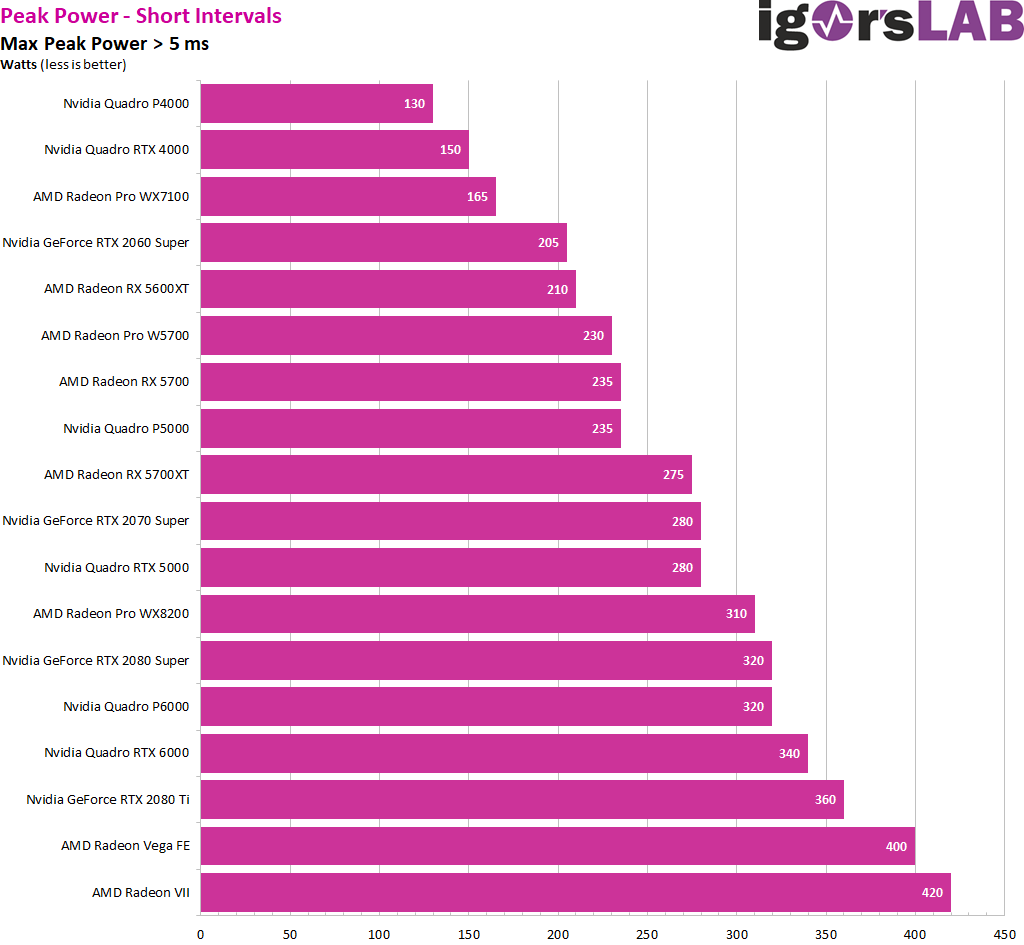Modern switching power supplies should not have any problems with the flowing currents, as they are generated by graphics cards, and I could not measure really sensationally high currents with any single card and in any different load situations. However, spikes of up to approx. 20 milliseconds are present, no question about it, because this is in the nature of things in applications with very different load changes. It’s no secret that AMD’s graphics cards switch in larger intervals than comparable Nvidia cards. But it’s not so crude that exorbitantly high currents are applied over many milliseconds. This is exactly what Power Tune knows how to prevent very safely.
As I have already proved several times in detail, there are also higher loads in the millisecond range, which can lead to unexplainable shutdowns if the power supplies are not well designed or not properly equipped. The TBP (Typical Board Power) measured by the graphics card manufacturer or the reviewers alone does not really help for a stable design of the system. This point is unfortunately very often neglected when it comes to the correct calculation and dimensioning of power supplies.
What I would advise, however, reserves or not, is an emotionless and in practice also clearly differentiated consideration of the possible power consumption or the flow of currents on the individual rails. To take the pure TBP (Typical Board Power) as a basis for a power supply calculation would be rather naive and it suddenly becomes obvious why graphics card manufacturers often estimate much higher values. This is not a job creation measure for the power supply industry, but pure caution.
Peaks with intervals between 1 and 20 ms can lead to undesired shutdowns with very fast reacting protective circuits (OPP, OCP), especially with multi-rail power supplies, although the average power consumption is still within the norm! Without a really detailed review in this area, it is of course very difficult to estimate where the power peaks are and how long the intervals between the peaks are in general. But the inclusion of the transients is essential for safe operation, because if the manufacturers of power supplies calculate one with a pointed pin, it’s the expensive capacitors.
Summary
The short-term power consumption of current graphics cards is sometimes considerably higher than the values given as an average or what chip manufacturers call Typical Board Power. These values are average values over a rather large interval. Depending on the quality of the secondary side of a power supply, the short-term load (1 to 10 ms) can be significantly higher. I would therefore recommend to take into account an additional 50 watts for power consumption ranges of the graphics card between 150 and 200 watts TBP and to add 100 watts to the reserve for high-end systems with a power consumption of 200 watts and more, if no exact tests exist. With that, the peculiarities of AMD and Nvidia cards should be well covered.
- 1 - Overview & Benchmark Selection
- 2 - Creo 3.0
- 3 - Solidworks 2019
- 4 - Solidworks 2019 Enhanced
- 5 - 3ds Max 2015
- 6 - Inventor Pro 2020
- 7 - Various CAD and Science Applications
- 8 - Windows GDI und GDI+ Driver Performance
- 9 - Rendering & Compute
- 10 - Adobe Premiere Pro 2020 & DaVinci Resolve 16
- 11 - Adobe Lightroom Classic (2020)
- 12 - Autodesk Maya 2019 and Arnold
- 13 - Blender RTX (OptiX) & OctaneBench
- 14 - Thermal Imaging / Infrared
- 15 - Power Consumption
- 16 - PSU Recommendation






























